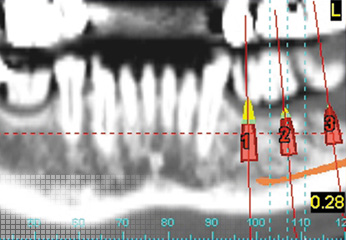


Bone Augmentation
How does bone loss happen?
As long as there are healthy teeth or dental implants anchored in the jaw bone, natural bone loss progresses only very slowly. However, as soon as a tooth is lost, the affected region is quickly suffering from an increased bone regression that takes place on a vertical and horizontal level. Within the first few weeks or months the loss of bone tissue is more severe than at any other time. If the jawbone is put under additional pressure through chewing or dentures, then it may continue at an accelerated rate even beyond the usual 2 year limit.
Various techniques to augment the bone
The optimal choice of a bone augmentation method depends largely on the size, type, and area of the defective bone tissue.
Further methods
Bone splitting, bone spreading, bone condensing, external and internal sinus lifts are some of the methods we have used alone or in combination with other bone augmentation techniques to prepare the bone tissue for implantation.
When is bone augmentation necessary?
As soon as the height and width of the remaining jaw ridge falls below a certain minimum measure, a bone augmentation must take place prior to implantation to greatly improve the long-term stability of your implants.
Nerve translocation / nerve lateralisation - an alternative to bone augmentation in the lower jaw
Bone regression may reduce the distance to the nerve in the lower jaw to such a degree that even the smallest implant would injure it. A translocation helps to lateralize the nerve to make space for one or more implants in that area. Obvious advantages of this method are the circumvention of bone augmentation and thus a substantial reduction in the duration of the treatment and its costs.



